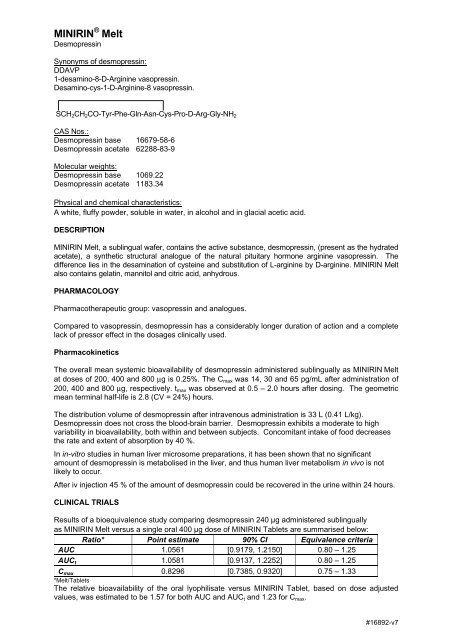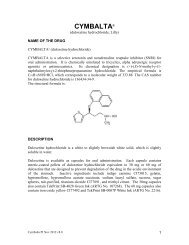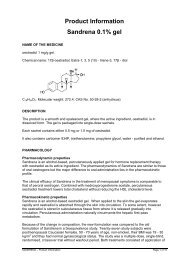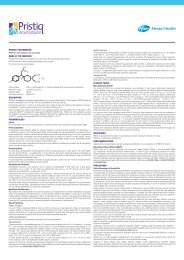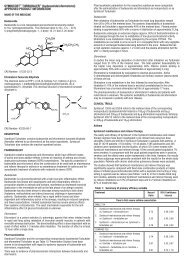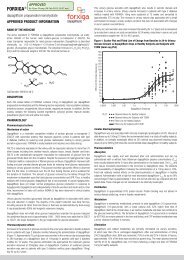MINIRIN Melt - DriveTime Radio Home Page
MINIRIN Melt - DriveTime Radio Home Page
MINIRIN Melt - DriveTime Radio Home Page
You also want an ePaper? Increase the reach of your titles
YUMPU automatically turns print PDFs into web optimized ePapers that Google loves.
<strong>MINIRIN</strong> ® <strong>Melt</strong><br />
Desmopressin<br />
Synonyms of desmopressin:<br />
DDAVP<br />
1-desamino-8-D-Arginine vasopressin.<br />
Desamino-cys-1-D-Arginine-8 vasopressin.<br />
SCH2CH2CO-Tyr-Phe-Gln-Asn-Cys-Pro-D-Arg-Gly-NH2<br />
CAS Nos.:<br />
Desmopressin base 16679-58-6<br />
Desmopressin acetate 62288-83-9<br />
Molecular weights:<br />
Desmopressin base 1069.22<br />
Desmopressin acetate 1183.34<br />
Physical and chemical characteristics:<br />
A white, fluffy powder, soluble in water, in alcohol and in glacial acetic acid.<br />
DESCRIPTION<br />
<strong>MINIRIN</strong> <strong>Melt</strong>, a sublingual wafer, contains the active substance, desmopressin, (present as the hydrated<br />
acetate), a synthetic structural analogue of the natural pituitary hormone arginine vasopressin. The<br />
difference lies in the desamination of cysteine and substitution of L-arginine by D-arginine. <strong>MINIRIN</strong> <strong>Melt</strong><br />
also contains gelatin, mannitol and citric acid, anhydrous.<br />
PHARMACOLOGY<br />
Pharmacotherapeutic group: vasopressin and analogues.<br />
Compared to vasopressin, desmopressin has a considerably longer duration of action and a complete<br />
lack of pressor effect in the dosages clinically used.<br />
Pharmacokinetics<br />
The overall mean systemic bioavailability of desmopressin administered sublingually as <strong>MINIRIN</strong> <strong>Melt</strong><br />
at doses of 200, 400 and 800 µg is 0.25%. The Cmax was 14, 30 and 65 pg/mL after administration of<br />
200, 400 and 800 µg, respectively. tmax was observed at 0.5 – 2.0 hours after dosing. The geometric<br />
mean terminal half-life is 2.8 (CV = 24%) hours.<br />
The distribution volume of desmopressin after intravenous administration is 33 L (0.41 L/kg).<br />
Desmopressin does not cross the blood-brain barrier. Desmopressin exhibits a moderate to high<br />
variability in bioavailability, both within and between subjects. Concomitant intake of food decreases<br />
the rate and extent of absorption by 40 %.<br />
In in-vitro studies in human liver microsome preparations, it has been shown that no significant<br />
amount of desmopressin is metabolised in the liver, and thus human liver metabolism in vivo is not<br />
likely to occur.<br />
After iv injection 45 % of the amount of desmopressin could be recovered in the urine within 24 hours.<br />
CLINICAL TRIALS<br />
Results of a bioequivalence study comparing desmopressin 240 µg administered sublingually<br />
as <strong>MINIRIN</strong> <strong>Melt</strong> versus a single oral 400 µg dose of <strong>MINIRIN</strong> Tablets are summarised below:<br />
Ratio* Point estimate 90% CI Equivalence criteria<br />
AUC 1.0561 [0.9179, 1.2150] 0.80 – 1.25<br />
AUCt 1.0581 [0.9137, 1.2252] 0.80 – 1.25<br />
Cmax 0.8296 [0.7385, 0.9320] 0.75 – 1.33<br />
*<strong>Melt</strong>/Tablets<br />
The relative bioavailability of the oral lyophilisate versus <strong>MINIRIN</strong> Tablet, based on dose adjusted<br />
values, was estimated to be 1.57 for both AUC and AUCt and 1.23 for Cmax.<br />
#16892-v7
INDICATIONS<br />
<strong>MINIRIN</strong> <strong>Melt</strong> is indicated for the treatment of<br />
• cranial diabetes insipidus<br />
• primary nocturnal enuresis in patients from 6 years of age with normal ability to concentrate<br />
urine, who are refractory to an enuresis alarm or in whom an enuresis alarm is<br />
contraindicated or inappropriate.<br />
CONTRAINDICATIONS<br />
<strong>MINIRIN</strong> <strong>Melt</strong> is contraindicated in:<br />
• Habitual or psychogenic polydipsia (resulting in a urine production exceeding 40 mL/kg/24<br />
hours);<br />
• A history of known or suspected cardiac insufficiency and other conditions requiring<br />
treatment with diuretics;<br />
• Moderate and severe renal insufficiency (creatinine clearance below 50 mL/min);<br />
• Known hyponatraemia;<br />
• Syndrome of inappropriate ADH secretion;<br />
• Hypersensitivity to desmopressin or to any of the excipients of <strong>MINIRIN</strong> <strong>Melt</strong>.<br />
PRECAUTIONS<br />
When used for primary nocturnal enuresis, fluid intake must be limited to a minimum, from 1 hour<br />
before until 8 hours after administration. Treatment without concomitant reduction of fluid intake may<br />
lead to water retention and/or hyponatraemia with or without accompanying warning signs and<br />
symptoms (headache, nausea/vomiting, weight gain, and, in severe cases, convulsions). In the event<br />
of signs or symptoms of water retention and/or hyponatraemia, treatment should be interrupted until the<br />
patient has fully recovered. When restarting treatment, strict fluid restriction should be enforced.<br />
In the event of signs or symptoms of water retention/hyponatraemia in cranial diabetes insipidus<br />
patients, treatment should be interrupted and the dose should be adjusted.<br />
Severe bladder dysfunction and outlet obstruction should be considered before starting treatment.<br />
Caution should be exercised in patients with other causes of urinary frequency (eg multiple sclerosis or<br />
urge incontinence), and in diabetes mellitus and renal impairment, since the use of desmopressin has not<br />
been well studied in these populations.<br />
Elderly patients and patients with low serum sodium levels may have an increased risk of<br />
hyponatraemia.<br />
Precautions to avoid hyponatraemia, including careful attention to fluid restrictions and more frequent<br />
monitoring of serum sodium, must be taken in:<br />
• conditions characterised by fluid and/or electrolyte imbalances (such as systemic infections,<br />
fever, gastronenteritis and syndrome of inappropriate ADH secretion (SIADH))<br />
• conditions requiring concomitant treatment with diuretic agents<br />
• concomitant treatment with drugs known to induce SIADH (see Interactions)<br />
• concomitant treatment with NSAIDs (see Interactions)<br />
Treatment with desmopressin should be interrupted during acute intercurrent illnesses characterised<br />
by fluid and/or electrolyte imbalance (such as systemic infections, fever, gastroenteritis).<br />
#16892-v7
Children should be closely observed to avoid over ingestion of fluid and to ensure that only the<br />
recommended dose of <strong>MINIRIN</strong> <strong>Melt</strong> is taken.<br />
For each approved indication the lowest effective dose should be used. Patient dosage should be<br />
reassessed periodically.<br />
<strong>MINIRIN</strong> <strong>Melt</strong> should not be administered to dehydrated or overhydrated patients until water balance<br />
has been adequately restored.<br />
<strong>MINIRIN</strong> <strong>Melt</strong> should be used with caution in patients with cystic fibrosis because of impaired water<br />
handling and increased risk of hyponatraemia.<br />
Carcinogenicity<br />
The carcinogenic potential of desmopressin has not been investigated in pre-clinical studies.<br />
Genotoxicity<br />
The genotoxic potential of desmopressin has not been adequately investigated, although in vitro<br />
studies in bacterial and mammalian cells revealed no mutagenicity of the drug<br />
Effects on Fertility<br />
No study has been conducted in animals to examine the potential effects of desmopressin on fertility.<br />
Use in Pregnancy (Category B2)<br />
Data on a limited number (n=53) of exposed pregnancies in women with diabetes insipidus indicate no<br />
adverse effects of desmopressin on pregnancy or on the health of the fetus/newborn child. However,<br />
these findings are based on case report data and should be interpreted with caution. No reproduction<br />
study has been conducted in animals using oral administration. Studies performed in rats and rabbits<br />
with cutaneous doses up to 50ng/kg/day and 10µg/kg/day, respectively, revealed no evidence for a<br />
harmful effect on the fetus. Caution should be exercised when prescribing to pregnant women.<br />
Use in Lactation<br />
No study has been conducted in animals to examine the effects of desmopressin on postnatal<br />
development.<br />
There have been no controlled studies in nursing mothers. In a single dose study in 6 lactating women<br />
administered 300µg desmopressin intranasally, the concentration of desmopressin was less in breast<br />
milk than in plasma. However, until further evidence is available for its safe use during lactation,<br />
desmopressin should not be used in breast feeding mothers.<br />
Interactions with Other Drugs<br />
• NSAIDs may induce water retention/hyponatraemia.<br />
• Substances which are known to induce SIADH, e.g. tricyclic antidepressants, selective<br />
serotonin reuptake inhibitors, chlorpromazine and carbamazepine, may cause an additive<br />
antidiuretic effect leading to an increased risk of water retention/hyponatraemia.<br />
• Concomitant treatment with loperamide may result in a 3-fold increase of desmopressin<br />
plasma concentrations, which may lead to an increased risk of water<br />
retention/hyponatraemia. Although not investigated, other drugs slowing intestinal transport<br />
might have the same effect.<br />
• It is unlikely that desmopressin will interact with drugs affecting hepatic metabolism, since<br />
desmopressin has been shown not to undergo significant liver metabolism in in vitro studies with<br />
human microsomes. However, formal in vivo interaction studies have not been performed.<br />
• A standardised 27% fat meal significantly decreased absorption (rate and extent) of <strong>MINIRIN</strong><br />
tablets. No significant effect was observed with respect to pharmacodynamics (urine production<br />
or osmolality). Food intake may reduce the intensity and duration of the antidiuretic effect at<br />
low oral doses of <strong>MINIRIN</strong> tablets.<br />
#16892-v7
EFFECTS ON ABILITY TO DRIVE AND USE MACHINES<br />
None<br />
ADVERSE REACTIONS<br />
Treatment with and without concomitant reduction of fluid intake may lead to water<br />
retention/hyponatraemia with or without accompanying warning signs and symptoms (headache,<br />
nausea/vomiting, decreased serum sodium, weight gain, and in severe cases, convulsions). The risk<br />
appears to be dose-related and the elderly (>60 years) are at increased risk.<br />
Cranial diabetes insipidus - During clinical trials with desmopressin in diabetes insipidus the following<br />
adverse events have been reported more than once: headache, cold, weight gain, dizziness, sore<br />
throat, and depressed mood.<br />
Primary nocturnal enuresis & diabetes insipidus:<br />
Common (>1/100) General: Headache<br />
GI: Abdominal pain, nausea<br />
Very rare (
Treatment: Although the treatment of hyponatraemia should be individualised, the following general<br />
recommendations can be given: discontinue the desmopressin treatment, fluid restriction, and<br />
symptomatic treatment if needed.<br />
PRESENTATION<br />
<strong>MINIRIN</strong> <strong>Melt</strong> 60 micrograms desmopressin. White, round, sublingual wafer marked with a drop<br />
shaped figure on one side. (Not currently available in Australia).<br />
<strong>MINIRIN</strong> <strong>Melt</strong> 120 micrograms desmopressin. White, round, sublingual wafer marked with two drop<br />
shaped figures on one side.<br />
<strong>MINIRIN</strong> <strong>Melt</strong> 240 micrograms desmopressin. White, round, sublingual wafer marked with three drop<br />
shaped figures on one side. (Not currently available in Australia).<br />
Desmopressin free base represents approximately 89% of the desmopressin acetate content. This is due<br />
to the presence of acetic acid/acetate, water and impurities.<br />
<strong>MINIRIN</strong> <strong>Melt</strong> is available in cartons of 10*, 30 or 100* each containing 1 to 10 Aluminium/Aluminium<br />
blister trays of 10 wafers. (*Not currently available in Australia).<br />
Storage<br />
Store below 25 o C. Keep in original container.<br />
POISON SCHEDULE OF THE DRUG<br />
Prescription Medicine<br />
NAME AND ADDRESS OF THE SPONSOR<br />
Ferring Pharmaceuticals Pty Ltd<br />
Suite 2B, Level 2,<br />
802 Pacific Highway,<br />
GORDON NSW 2072<br />
AUSTRALIA<br />
Date of the TGA approval: 21 st June 2007<br />
Date of most recent amendment: 15 th October 2008<br />
#16892-v7


